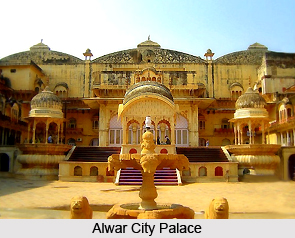 Alwar City Palace, situated in Alwar city of Rajasthan, exhibits a beautiful amalgamation of Rajput and Mughal architectural styles. The city is set on the foothills of Aravali range and is the place to witness the glimpses of bygone eras through its historical monuments. Alwar city palace is a significant one among these, which was constructed in 1793 A.D. by Raja Bakhtawar Singh, before the rise of Mughal Empire. Standing on a hill top the magnificent monument is a prominent landmark of the buzzing city. It renders an enchanting aura which reminds of the palace`s glory in the bygone era. It is also known as `Vinay Vilas Mahal`. Presently it serves as the District Collectorate and its chambers and halls as government offices.
Alwar City Palace, situated in Alwar city of Rajasthan, exhibits a beautiful amalgamation of Rajput and Mughal architectural styles. The city is set on the foothills of Aravali range and is the place to witness the glimpses of bygone eras through its historical monuments. Alwar city palace is a significant one among these, which was constructed in 1793 A.D. by Raja Bakhtawar Singh, before the rise of Mughal Empire. Standing on a hill top the magnificent monument is a prominent landmark of the buzzing city. It renders an enchanting aura which reminds of the palace`s glory in the bygone era. It is also known as `Vinay Vilas Mahal`. Presently it serves as the District Collectorate and its chambers and halls as government offices.
Architecture of Alwar City Palace
Alwar city palace comprises 51 small towers and 15 imposing towers overlooking the slopes of the mountains. Another notable feature of the palace is formed by its 446 openings for musketry. The palace has several entry points and the name of each gate bears a special significance. Some of the entry points of the palace are named as Andheri Gate, Kishan Pol, Chand Pol, Laxman Pol, Suraj Pol and Jai Pol.
Interiors of Alwar City Palace
Alwar city palace is an impressive structure stretching up to 5 kilometres from east to west and rises to an altitude of 595 meters above the sea level and 304 meters above the city. It has a central courtyard having a lotus flower base made of marble. In the remote past, the palace had sheltered some of the eminent Mughal emperors including Babur and Jahangir. The interiors of the palace give glimpses of the royal life style of the rulers who dwelled here. Various ancient artefacts are found in the Alwar city palace among which the most popular one is a precious cup carved out of a single piece of raw emerald. Another such artefact is an enormous double storied four-elephant carriage. It is said that the Mughal emperor Jahangir had spent a night in one of the halls of the palace which is referred to as `Salim Mahal`. In 1775 A.D. the fort was conquered by Maharaja Pratap Singh who took away a lot of palace treasures. There is a gilded `Durbar Hall` in the palace which houses a raised platform on which a gold and velvet throne stands. The ceilings and walls of Alwar city palace are adorned with exquisite murals and mirror works.
Museum at Alwar City Palace
The palace also houses a museum on the upper floor which has preserved much of its ancient history. It exhibits a splendid assortment of personal wealth of the Maharajas of Alwar. Its artefacts also include some rare manuscripts along with a 200 feet long scroll illustrating Mahabharata. Other precious manuscripts are Shah Nama, Gulistan and one on Emperor Babur`s life. A wondrous range of miniature and Ragamala paintings belonging to the Alwar, Mughal and Bundi schools have been displayed which till date flaunts its fresh and vivid hues. The museum also hosts an unusual silver table. Its huge collection of armoury comprises historic swords belonging to Akbar, Aurangzeb, Sultan Muhammad Ghori and other rulers.



















